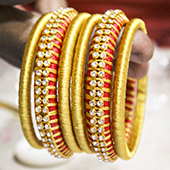Design Resource
Silk Thread Jewelry - Ahmednagar, Maharashtra
Ethnic Handicraft
by
Prof. Bibhudutta Baraland Srikanth B
Jewelry arose out of the need and desire to adorn or protect one’s body. As society progressed, the jewelry also evolved in its form and conceptual aspects. According to legends, before precious metals were discovered, people who lived along the seashore decorated themselves with a great variety of items obtained from the sea like shells, pebbles, fish bones, fish teeth, etc. While the inhabitants of the mainland created unique wearables from animal bones, especially of the animals hunted for food like reindeer, mammoth, snacks, buffalo, fox, etc. Later civilizations of Egypt became the first to explore metallurgy science, which gave rise to a jewelry tradition that stayed for several thousand years and occurred to be a strong inspiration for many European civilizations that were the successors. Jewelry in India is as old as civilization itself. The excavated lands of Bharhut, Sanchi, Amaravathi, and Ajanta are the living evidence of the prevalence of a wide range of jewelry that existed in India. The 3300 BCE Indus valley civilization also has left traces of beaded and embroidered jewelry worn by men and women. With heightened beliefs in mysticism, certain types of stones were affixed onto the jewelry to protect one from evil forces in the ancient days. Society then witnessed a wave of change in jewelry production during the Mughal rule, which brought in styles similar to present-day Kundan and Minakari. These styles are very much in use in the northern part of the country even today. While the embellishments on South Indian jewelry stuck to inspirations by nature, it has floral patterns, leaves, raindrops, clouds, stars, etc. If divided into two, these two territories are famous for their set of jewelry, like South India makes more chains and necklaces while North India is renowned for bangles and nose rings.
In India, the varieties of jewelry are enormous, as we create metal fashion for head to toe. The materials used for them range from ivory, navaratna, beads, thread, terracotta, paper, crochet, etc., thus forming different forms. These styles are often blended with precious stones or metals to improve their grandeur. Here thread jewelry is the latest in vogue, which incorporates the use of natural or synthetic fibers to create unique jewelry products. Natural fibers always have an advantage over the synthetic variety for their innate capabilities to withstand climatic changes and foster comfort. Cotton is the most commonly used natural fiber to make a thread. After the thread is manufactured, it is then set through a dying process, where types like Vat, Fiber Reactive, and Direct dyes are treated for fast results and perfection. Kavitha Vinayak Gudewar is a renowned thread jewelry artist from Ahmednagar, part of Maharashtra, who since her childhood has been practicing the art and now serves a wide array of customers spread across the state.






